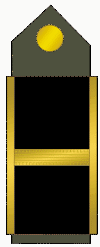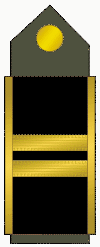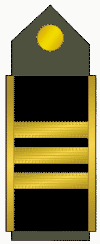Somali Gendarmerie (Italian Empire): Difference between revisions
(Created page with "{{Infobox military unit | unit_name =Somali Gendarmerie | native_name =Gandarmaariiga ee Soomaaliya<br>الدرك من الصومال<br>Gendarmeria della Somalia | image =Fi...") |
mNo edit summary |
||
| Line 19: | Line 19: | ||
| patron = | | patron = | ||
| motto = | | motto = | ||
| colours = | |||
| colors_label = <!-- or | colours_label = --> | | colors_label = <!-- or | colours_label = --> | ||
| march = | | march = | ||
Revision as of 09:56, 22 October 2019
The Gendarmerie of Somalia (Somali: Gandarmaariiga ee Soomaaliya; Arabic: الدرك من الصومال, al Ddarak min al Ssumal; Italian: Gendarmeria della Somalia) is the national gendarmerie force and the law enforcement agency of the Autonomous Social Republic of Somalia. As with most other police forces in the world, its duties include crime fighting (including the enforcement of the Xeer), traffic control, maintaining public security, and counter-terrorism. It is under the jurisdiction of the Minister of Interior, Directorate-General of Public Security.
The Gendarmerie serves as one of the principal organs of the Somali Government. While organised at a national level, each arm reports to a Regional police authority, which in turn divides its force by local Police Divisions, headquartered at local police stations. In an emergency, the Gendarmerie can be reached by dialing 888 from any telephone in Somalia.
A military atmosphere prevails - dress codes, behavior standards, and rank differentiations are strictly adhered to. Esprit de corps is inculcated with regular ceremonies and institutionalization of rituals such as applauding personnel dispatched to or returning from assignments and formally welcoming senior officers to the mess hall at all meals.
History
The Gendarmerie of Somalia was formally established on 1 December 1960, following the dissolution of the Italian African Police; the newly established Gendarmerie corps inherited about 1,200 Somali policemen and 800 Italian policemen. Shortly afterwards, the Gendarmerie absorbed the Higher Command Carabinieri Somalia on 1 February 1962.
After a transitional phase, Schools and other facilities were established by 1967 (Subofficers School in 1958, Officers School in 1964). The first commander was former P.A.I. Colonel Graziano Funari, and all officers were Italians or Italian Somalis until 1972.
Starting from the mid-1970s, the corps pursued a moderate "somalization" policy in order to enable indigenous Officers to take command and senior management, also because the ongoing debate in Italy wether the former colonies had to be disbanded or not. The first Somali commander was Colonel Jaamac Qoorsheel, who held command from 1976 to 1979. Nevertheless, Italian Somali presence has remained significant through the years.
Organisation
Officers and agents of the Somali Gendarmerie depend on their superiors. For institutional services the Corps Commands depend on government authorities having jurisdiction over the area where they are located. Those authorities, except in extraordinary cases, only turn to commanders who then give nocessarie provisions.
The Gendarmerie manages a type of recruitment characterised as "intertribal" with a double physiognomy of territorial organisation (Stations and Fixed Police posts), with integrated mobile Units that if necessary act in favour of nomads, also interposing in the clashes between them for grounds for grazing and exploitation of springs.
The organisation of the Gendarmerie follows both the demographics of Somalia and the administrative divisions. Broadly speaking, the Gendarmerie has a Territorial Organisation, a Mobile Organisation (for riot control and armed services) and a Training Organisation; some specialist units are directly attached to the General Command. The organisation is closely modelled on the Carabinieri structure, with further adaptations in order to deal with scarce population density and arising security needs.
Police Schools are all based in Mogadiscio. There are training courses dedicated to officers, inspectors and subofficers, while newly recruited troops are trained at their Group Commands; there are also technical validation courses for subofficers and specialization courses.
General Command
At its top, the Gendarmerie has the General Command, based in Mogadishu, led by a Commander (a Major General), who is assisted by a Deputy Commander and a Chief of Staff (both Brigadier Generals). The Deputy Commander leads the Specialist Units Command, which consists of:
- Integrated Investigative Office;
- Tributary Police Group;
- Anti-drug Police Group;
- Banditry Police Office (tasked with investigative work in supporting mobile forces);
- Specialised Stock Theft Prevention Unit;
- Special Research Office;
- Counter-Terrorism Unit;
- Judicial and Political Database;
- Port Police Office (mainly in charge for ports of Mogadicio, Bender Cassim, Berbera and Gibuti where it has dedicated Groups);
- Traffic Police Office (Gadidka Poliska);
- Communications and Support Office;
- Border Control Unit;
- General and National Administrative Affairs Group;
The Health Service, the Logistics Service and the Personnel Service depend on the Chief of Staff.
Territorial organisation
For central administrative purposes, Somalia is divided into 19 Regions (Gobollada, singular Gobol), which in turn are subdivided into districts. In each Region there is a Gendarmerie Group, commanded by a Lieutenant Colonel or, for most populated Regions, by a Colonel. Each Group has a Command, some Companies (at least one per District) and several Stations and Posts. Each of the country's regions has a police commandant; other commissioned officers maintain law and order in the districts. Within Groups and Companies, both information and investigative squads and teams operate in the territories. 6 multi-regional boundaries also exist for security and tactical planning purposes; the latter's boundaries are the same of the States. Each State issues its own interpretation of the Xeer and different groups may issue their own official position; each Regional Command may be requested by the Constituent State authorities to enforce a duly issued Xeer sentence.
Each State also provides the general administration to the relevant territory; each Multiregional Command has an administrative police structure.
Mobile forces
The Mobile organisation is a mobile group used to keep peace between unresting clans in the interior. The first iteration of the mobile force consisted of the Mobile Border Nucleus (Nucleo Mobile di Frontiera), a Battalion with the task of guarding the Somali-Ethiopian and the Somali-Kenyan borders based in Belet Uen, and of the Celere Police Unit (Reparto Celere di Polizia), based in Mogadiscio. Both units were established back in 1950s, and existed until 1968.
Nowadays, the force (Birmadka Poliska) is structured as two large Regiments with a total of ten Mobile Battalions. The 1st Gendarmerie Regiment, which inherited traditions from the Celere Police Unit, has its headquarters in Mogadiscio, while individual Battalions are based in Mogadiscio, Beledweyne, Kismayo, Marka and Hobyo; the 2nd Gendarmerie Regiment, successor of the Mobile Border Nucleus, is based in Rocca Littorio (also known as Gallicaio), while individual Battalions are based in Rocca Littorio, Bosaso, Berbera, Borama and Gibuti. Tasks entrusted to the Mobile Battalions are riot control, maintenance of public order and security and counter-insurgency.
In addition, an autonomous Helicopter Squadrons Group, directly dependent on the General Command, is based in Garoowe. In order to deal with rough terrain, sparse and semi-nomadic populations and security needs, two autonomous Long Range Patrol Companies (Darawishta Poliska) are set up in Baidoa and in Rocca Littorio and are also available for military needs.
While Darawishta members attend a six-month tactical training course, Birmadka personnel receive training in public order and riot control.
Personnel and training
Beginning in the early 1960s, Gendarmerie recruits have to be seventeen to twenty-five years of age, of high moral caliber, and physically fit. All training activities are framed and coordinated by the Training Command.
After the recruits complete this service, the Gendarmerie could request renewal of their contracts. Officer cadets underwent a two-years long training course that emphasize supervision of police field performance. Subofficers and Officers are also politically motivated.
Issues
The functioning of the Somali Gendarmerie is seen as problematic, especially regarding corruption, clan-based favouritism, lack of impartiality, and human rights violations.
Ranks and Inisgnia
The Somali Gendarmerie is led by a Brigadier General; when the General-Inspector of the Militarized Police Corps or the Chief of Police conduct their inspections and visits, he wears his Italian uniform. From a graphic point of view, the officer insignia pattern are loosely inspired to the Italian trend, with the Italian Towered Crown (symbol of the Itaian State) being replaced by the Somalian seal.
All officer rank insignia feature the Star insignia as basic component. As a whole, the Somali Gendarmerie is a State military corps, like the Royal Police Corps or the Royal Carabinieri, and is part of the Italian military system, although its State is Somalia within the Italian Empire, and not the Kingdom of Italy strictu sensu.
A common feature for all ranks is the round cap emblem, featuring the Latin wording "GAANDARMARIIGA - WAX DAN AH KAMA".
















